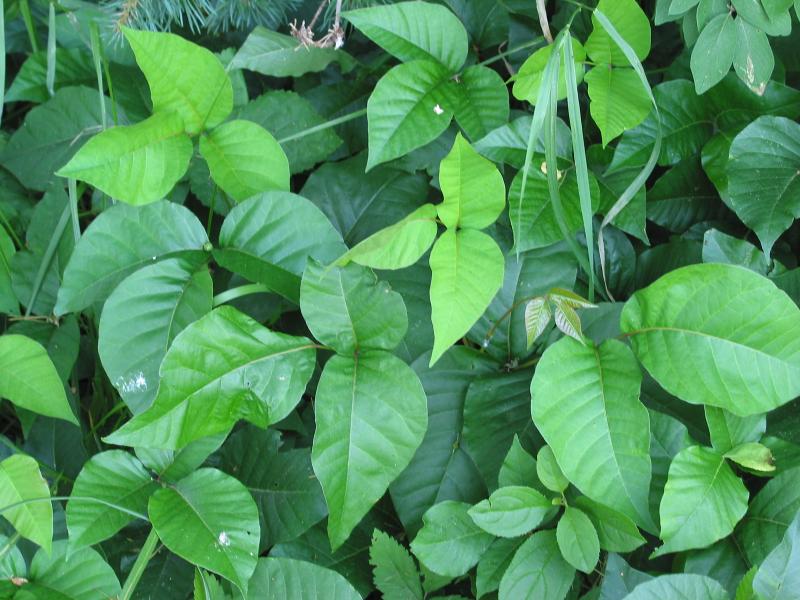This blog contains affiliate links. Thanks for your support 🙏
 “Leaves of three, let them be.” Sounds familiar to many of us, yes? This quote refers to the dreaded poison oak and poison ivy, plants which line the hiking trails and woods of much of the world. To protect themselves from being eaten, these hardy weeds have developed a very effective defense: their shiny leaves are coated in an incredibly reactive oil which causes a severe local, swollen and weeping rash, which often burns but mostly is incredibly itchy. I’m sure this deters a lot of second attempts from bugs and birds, but for us hapless humans, we just get the rash if we even lightly brush their leaves. Lucky ones barely notice a rash, but the hypersensitive people can have severe rashes covering much of their body, and they feel miserable — sometimes for weeks!
“Leaves of three, let them be.” Sounds familiar to many of us, yes? This quote refers to the dreaded poison oak and poison ivy, plants which line the hiking trails and woods of much of the world. To protect themselves from being eaten, these hardy weeds have developed a very effective defense: their shiny leaves are coated in an incredibly reactive oil which causes a severe local, swollen and weeping rash, which often burns but mostly is incredibly itchy. I’m sure this deters a lot of second attempts from bugs and birds, but for us hapless humans, we just get the rash if we even lightly brush their leaves. Lucky ones barely notice a rash, but the hypersensitive people can have severe rashes covering much of their body, and they feel miserable — sometimes for weeks!
When I was growing up, I often played in our woods or picked blueberries just along our fence, and more often than not I’d develop that classic raised, shiny, wet, and super itchy rash. My mom still gets really bad attacks and often needs to take steroid pills to cool it off. Some very unlucky people get the rash in their eyes and mouth and may need prescription medicines, injections or even hospitalization. That’s why the #1 way to prevent this nuisance is to follow the quote — and avoid touching them!
But to avoid these ubiquitous plants, you first need to know what they look like. Thus the quote: both poison oak and poison ivy have a classic clustering of three leaves, so if you see any shiny “leaves of three” along your path or in the vines and low trees, it’s definitely safer to avoid them. They are usually along the ground but definitely can climb up other plants, so it’s very easy to brush past these if your hiking path is a bit overgrown with plants.
It’s inevitable to come into contact with these plants, so it’s always best to keep well covered when trekking outside. Wearing socks helps a lot, otherwise it’s very easy to get the rash on your ankles and feet. Moms need to know that these plants’ itchy oil can cling to clothes for days, so it’s best to wash the day’s outdoor clothes in hot water to dissolve the oils. And don’t forget that your dog’s hair can definitely carry the oils into the house and spread to anyone petting him, so he may need a good soap and water bath.
It takes at least a few hours to days to develop the rash, so it’s a must to use soap and water after your outdoor activities to get off that oil before it absorbs into your skin. Once the oil is gone, it can’t spread anywhere else.
 If you’re unlucky enough to get the rash, there are many home remedies and over the counter (OTC) medicines you can try. My favorite is the pink stuff — calamine lotion. It’s extremely soothing and cooling, and every home’s medicine cabinet should have a bottle of this. The other must-have is a topical steroid cream such as hydrocortisone 1%. This directly helps reverse or control the body’s allergic reaction. Other important medicines may include the anti-allergy medicines, especially the older versions such as diphendydramine (Benadryl) pills and syrups. These work great for a few hours and also help kids sleep better, as they are very sedating. The newer allergy medicines such as Clarityn cause less sedation and are only taken once a day, but they may not be as effective. If you or your child are still miserable, or if it’s around their eyes or in their throat, it’s definitely time to see the doctor.
If you’re unlucky enough to get the rash, there are many home remedies and over the counter (OTC) medicines you can try. My favorite is the pink stuff — calamine lotion. It’s extremely soothing and cooling, and every home’s medicine cabinet should have a bottle of this. The other must-have is a topical steroid cream such as hydrocortisone 1%. This directly helps reverse or control the body’s allergic reaction. Other important medicines may include the anti-allergy medicines, especially the older versions such as diphendydramine (Benadryl) pills and syrups. These work great for a few hours and also help kids sleep better, as they are very sedating. The newer allergy medicines such as Clarityn cause less sedation and are only taken once a day, but they may not be as effective. If you or your child are still miserable, or if it’s around their eyes or in their throat, it’s definitely time to see the doctor.
As you can see, this “rite of passage” is best avoided, so let’s all chant together with your kids: “leaves of three, let them be”!
(This article was originally printed in Beijing Kids magazine, where I am a contributing editor. You can click here to read the rest of my BeijingKids “The Doc Is In” columns.)
Discover more from Richard Saint Cyr MD
Subscribe to get the latest posts sent to your email.
